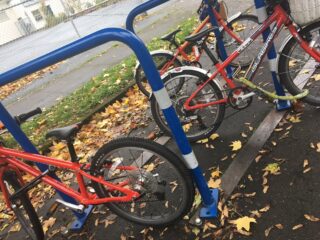
(Photos: Jonathan Maus/BikePortland)
It’s been a tough year for Portland’s bike industry.
In May, local cargo bike maker Metrofiets called it quits. Then in July, bike shop and community gathering spot Velo Cult announced it would no longer have a retail location. And on Tuesday of this week we reported that UK-based Islabikes decided to close the local office and warehouse that housed their North American headquarters. And yesterday we shared the messy road that led to the end of Renovo Hardwood Bicycles.
I don’t enjoy reporting these type of stories, but I do think the community deserves to know a reasonable amount of detail about them. Given Islabikes’ popularity and large role in our community (as a sponsor and partner of many local events), I felt like their official statement wasn’t enough. Earlier this week, I reached out to Islabikes General Manager Tim Goodall and asked him to share more about why they’ve decided to leave.
Goodall cited Brexit (the UK’s decision to leave the European Union) and a pesky US federal government regulation as two of the main reasons.
“We refused to send bikes that were non-compliant and we also refused to compromise our geometry to meet the requirements,”
— Islabikes GM Tim Goodall on a CPSC regulation that requires children’s bikes to have a coaster brake
As we’ve reported, Islabikes said they want to focus on the UK and EU markets. Behind that intent is what Goodall now says is a concern about the impacts of Brexit. The decision to leave the EU came via a very narrow voter referendum in 2016 and and the official exit is scheduled to occur in March 2019. However, the UK and EU must sign an agreement before it can happen and the debate over that agreement is far from over.
“The uncertainly of Brexit gives any company operating between the UK and EU pause at the moment,” Goodall shared with me via email yesterday. “Islabikes needs to dedicate time and energy to ensure that we’re growing those markets during whatever transition comes.”
I also asked Goodall if their decision had anything to do with a soft US market for high-quality children’s bikes that are much more expensive than big-box and “toy” store options. “The first few years were very strong and encouraging and we definitely think there is room for high-quality kids bikes in the US,” he said. Since Islabikes launched in 2013 several other high-quality children’s bike brands have launched. Was that competition the last straw? “The fact that so many brands with similar missions have sprung up definitely made the piece of the pie we have a bit smaller!” Goodall explained, “But the fact that those brands have come about is also encouraging. Islabikes mission from the start has been to provide children with a better experience riding bikes – there are more and more quality options out there for young riders.”
Advertisement
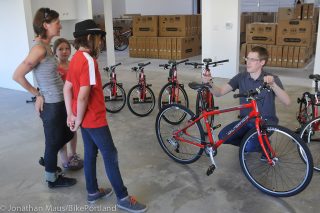
Then he mentioned a surprise reason: A Consumer Product Safety Commission (CPSC) requirement that children’s bicycles (defined as “sidewalk bicycles” by the CPSC) must be equipped with a footbrake (a.k.a. coaster brake, which activates by pedaling backwards). This regulation means all of Islabikes’ popular 14 and 16-inch models must be shipped with a coaster brake.
“We refused to send bikes that were non-compliant and we also refused to compromise our geometry to meet the requirements,” Goodall explained. “Over the past two years we’ve spent vast sums as well as countless hours in an attempt to enact a rule change.” Goodall says the coaster brake requirement is “woefully outdated” and even without a US presence Islabikes hopes it changes someday.
Leaving the US wasn’t part of the plan for Islabikes, but the political uncertainty of Brexit forced them to re-visit their decision.
“The fact that we are letting down our customers weighs heavily on our minds and in no way was the decision taken lightly,” Goodall shared.
We are bummed to see them go. Not only does Islabikes have a great product, the company is full of integrity and Goodall himself is a testament to that. “We relish the connections we have made in our five years in Portland,” Goodall shared with us. “From Sunday Parkways to Kids’ Cross – we have loved seeing our customers out doing what they do best – riding bikes with a smile on their face.”
— Jonathan Maus: (503) 706-8804, @jonathan_maus on Twitter and jonathan@bikeportland.org
Never miss a story. Sign-up for the daily BP Headlines email.
BikePortland needs your support.

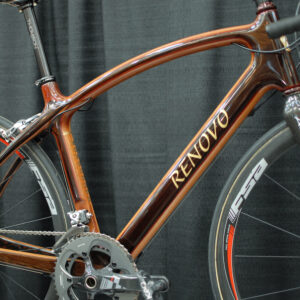
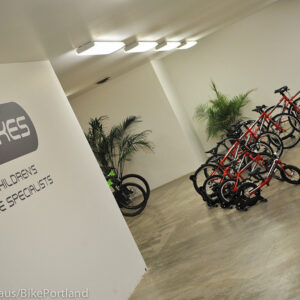
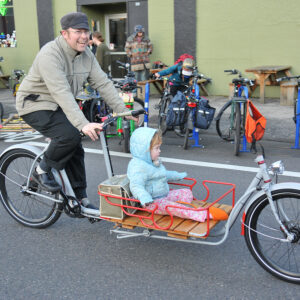

Thanks for reading.
BikePortland has served this community with independent community journalism since 2005. We rely on subscriptions from readers like you to survive. Your financial support is vital in keeping this valuable resource alive and well.
Please subscribe today to strengthen and expand our work.
“children’s bicycles (defined as “sidewalk bicycles” by the CPSC) must be equipped with a footbrake (a.k.a. coaster brake, which activates by pedaling backwards).”
People who don’t ride bikes wrote these rules.
A fascinating aspect of the decision. One would like to know how these rules came about…
Looks like it boils down to §1512.18(f)
(f) Sidewalk bicycle footbrake force test. For sidewalk bicycles, the footbrake force test is the same as for bicycles except; the brake force transmitted to the rear wheel shall continually increase as the pedal force is increased from 44.5 N to 225 N (10 to 50 lbf). The ratio of applied pedal force to braking force shall not be greater than two-to-one.
And how to change them!
I think the bottom line is that some regulator decided that children under a certain age couldn’t be trusted to use hand brakes. My 2 year-old begs to differ.
This brake discussion comes down two segments.
1512.5 (e) Sidewalk bicycles. (1) Sidewalk bicycles shall not have handbrakes only.
and
1512.5 (b) Sidewalk bicycle means a bicycle with a seat height of no more than 635 mm (25.0 in); the seat height is measured with the seat adjusted to its highest position.
Seems to me ‘twould be in keeping with the rules to ship the bike with a long seatpost and a hacksaw.
zoobomb!
Spawn Cycles gets around this by shipping them with two seat posts: one very long one that you probably won’t use, and a normal one. I’m surprised that Islabikes didn’t use this approach.
The first time I met Tim Goodall, he was volunteering for the BTA helping to maintain their fleet of kids bikes for Bike Safety Education. That was soon after he arrived in Portland. As soon as he got here he started looking around for a way to make a contribution to the community.
From the CPSC: “(b) Handbrakes. Handbrakes shall be tested at least ten times by applying a force sufficient to cause the handlever to contact the handlebar…”
Sounds like the brakes are out of adjustment.
I see where the CPSC is coming from, and it’s the Stone Age. There was definitely a time when five year olds didn’t have the strength needed to operate hand brakes, but nowadays their only limit is the ability brace against being thrown.
My kid’s first pedal bike was a Schwinn Duro 16 that had brakes he couldn’t operate by hand. They were crap – I could barely get them to function myself. I removed them and had him use the coaster brake.
If what’s present are v-brakes in dry conditions (or disc brakes), adjusted well, with aluminum rims, decent pads, and _levers intended for very small hands_ (present on Islabikes and other specialty brands but not on little bikes from big-box stores), then a small kid will have enough slowing/stopping power by hand and a freewheel is cool. Otherwise, being able to use the leg muscles for slowing/stopping is the way to go.
How’s that for a first draft of new legislation?
Here’s an option: just eliminate the requirement. Let’s let the bike builders and parents decide.
I don’t think safety rules on kids bikes (and lots of other things) are inherently bad. How many parents buying a kids bike from WalMart are going to carefully consider the braking system to make sure it will work well and is usable by their toddler when called upon? The regulation simply needs to be current and allow performance-based flexibility.
I think this coaster brake law goes back to my childhood when we all rode schwinn stingrays with fat slicks on the back. The caliper brakes of the era would not fit around such tires so they only had coasters or coasters plus weak hand brakes on the smaller front tires. Glad to see that the CPSC is so up to date. Too bad they don’t also regulate cars , if they did I am sure autos would have to have a special hook to hold the reins while they are adjusting the harness on their steeds
My earliest memory of riding a bike was blowing out my tire by repeatedly skidding with a coaster break. Must have been about 1966. Nice to know the CPSC wants future generations of children to experience this trill.
Children learn to ride tricycles, which are fixed-gear, first.
Transition to bicycles would be easier if those were fixed-gear too.
Many children learn to ride on balance bikes. My child started on an Islabike balance bike with a hand brake just before age 2, and was safely riding a 14″ wheeled pedal bike with two hand brakes (no coaster brake) two weeks before her 3rd birthday. I don’t think fixed gear is the right way to go for 2-4 year-olds.
I also only had a coaster brake on my little kiddie bike back in the States. It’s funny how the coaster brake has a reputation/stereotype of being either almost exclusively for kids’ bikes or very cheap/crappy ones. The vast majority of bikes here in the Netherlands have coaster brakes; while more and more newer bikes also have a front brake, many of them only have the coaster brake. There are definitely advantages to both systems. But I’m very happy with the coaster brake on both of my omafiets.
Another interesting thing I didn’t know until moving here was the purpose of the little rubber tube you have in all tube repair kits. For years, I was puzzled what that was meant for, and no one else knew either. But most Dutch bikes also have a different valve system (Dunlop) that makes use of that. I wonder if this system was also present in the States at one time.
Much of makes/made Portland a great place for bicycling was people who put their hearts and souls into creating a business niche for something that they loved doing. As time moves on, many of these businesses have failed to provide the growth needed for their proprietors to move on from a “labor of love” to a viable business.
Remember to support your local bicycle industry favorites.
Go out and buy something locally made next time your shopping for bicycles or accessories.
Or, you can support Portland’ bicycle news blog here.
https://bikeportland.org/subscribe
I hope BikePortland.org will continue to be viable as a business, a labor of love, or ideally both, well into the future. But like these other businesses, it may require more of our financial support than it currently has to do so.
Ted Buehler
The usual legislative drivel by people who seem to know nowt’ about children. Any kid’s bike with properly designed and proportioned hand brakes can be stopped by kids. We’ve got Islabike Cnoc 14 and 16 bikes in our selection and the nippers don’t have any trouble with them. As other posters have said, coaster brakes date back to a time when kids’ bikes were truly awful from a morphological viewpoint and couldn’t be stopped without the use of leg power.
As a coach, another objection I have against them is that it is almost impossible to teach them how to adopt the “pedal up/pedal ready” position to start off easily, since back pedalling to lift the pedal to level with the downtube is can’t be done if the pedal is already in the wrong place.
Aaaarrrggghhh!
Gosh, they’re certainly not wrong about the coaster brake being an issue. We went with a different specialty kids’ brand for that very reason. I wonder how the other high end brands get away with it.
Sad to see this happen. My kid LOVED his Islabike. It allowed him to keep up and enjoy longer rides with adults.
I don’t see the big deal about the coaster-brake requirement. It only applies to 16″ and smaller wheels, right? By the time they’re in late grade school and actually ready to use hand brakes, they’re mostly moving up to 20″ or bigger wheels, where the requirement no longer applies.
My kid was able to use properly-sized hand brakes at age 2. She won’t be riding a 20″ bike for at least two more years.